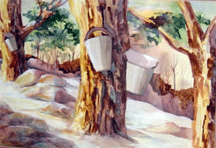
Victorian Pattern Glass
Syrup & Molasses
Cans, Jugs or Pitchers
Store!
 |
WELCOME TO THE Victorian Pattern Glass Syrup & Molasses Cans, Jugs or Pitchers Store! |
Until the mid 1800s, refined white sugar was a comparatively scarce & expensive luxury. Coarse brown sugar, molasses, sorghum & to a lesser extend, maple sugar & syrup were the sweeteners of the 'everyday housewife'. According to some old catalogues, syrup pitchers (called "syrups" for short) were originally called molasses cans, or syrup jugs. Syrups came in a variety of colorful containers in a different styles of glass products both blown & molded. |
To learn how to purchase from PatternGlass.com, click HERE
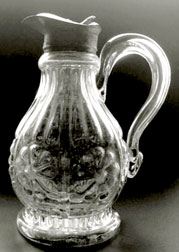 |
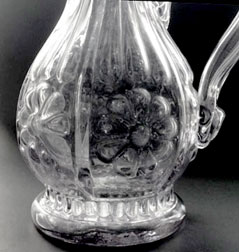 |
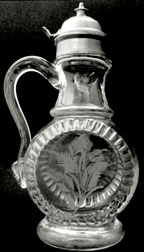 |
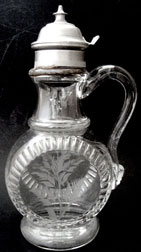 |
| ROSE MEDALLION is the name of this extremely rare 1875 syrup pitcher by King & Sons. It is apparently not part of a multi- form pattern. It is shown in this early advertisement seen HERE. The handle is applied. $325 |
This syrup pitcher is named PILGRIM & is a stand-alone form by Central Glass Co, their No. 731. See Catalog picture HERE. It has an applied handle & fabulous engraving on both sides. Made 1870s. $85 |
||
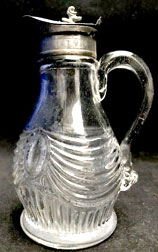 |
||
| LINCOLN DRAPE This syrup pitcher is scarce & especially hard to find with a working original tin lid. **SOLD** |
||
 |
 |
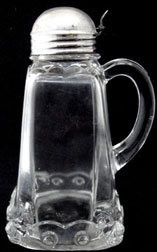 |
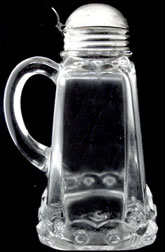 |
This is Fostoria's HARTFORD pattern molasses can, their #501. It was made ca. 1893 - 1901.
|
ATLANTA aka Square Lion is Fostoria's pattern #500. It has the clear lion heads on 4 corners of the base. See also HERE. This is a very difficult piece to find in this exquisite pattern. The lid & glass are in very good condition. $350 |
||
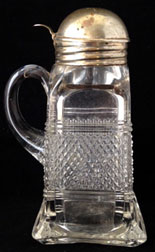 |
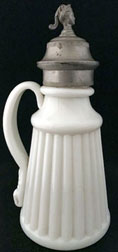 |
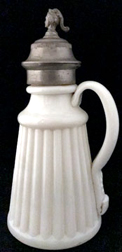 |
| HARTFORD's syrup pitcher which is listed but undescribed in the pattern. **SOLD** |
A RIBBED PATTERN early milk glass Syrup pitcher with a Knight's Head finial on the heavy metal lid. The handle is applied. There is a very faint manufacturing flaw in the base seen HERE. $125 |
|
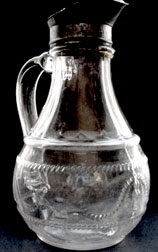 |
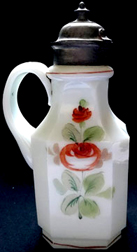 |
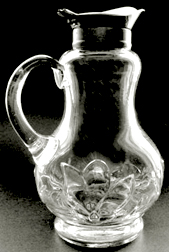 |
| CORD & TASSEL A rare blown form of this early pattern by LaBelle Glass Co. ca. 1872. $175 |
PRESSED OCTAGON |
MAGNOLIA a blown scarce form of this pattern; applied handle. By Consolidated Lamp & Glass Co. ca. 1891. $125 |
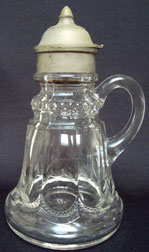 |
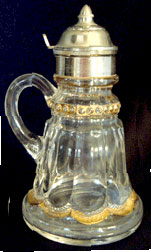 |
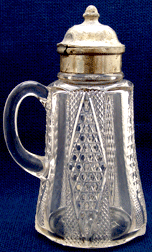 |
| EMPRESS by Riverside Glass Co. ca. 1898. No gold and no thumb tab. Otherwise pristine. $75 |
EMPRESS, Riverside's No 92. Excellent metal and gold decor. Ca. 1898. $195 |
CARMEN Fostoria's pattern #575 c. 1896. A scarce piece per Heacock. **SOLD** |
 |
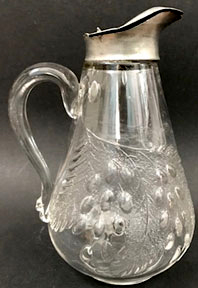 |
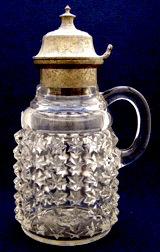 |
| IVY IN SNOW aka FOREST WARE by Co-op Flint Glass Works c. 1894. It is slightly discolored & has a chip on the base. $95 |
BARBERRY pattern was made by McKee and the Boston Sandwich Glass Co.
in the 1850s. It has an applied handle & is blown molded. $165. |
EFFULGENT STAR pattern is a product of the Central Glass Co. c. 1880s. It will need a new lid; this one for photo only. $77 |
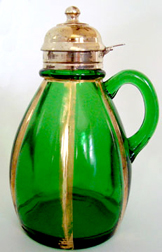 |
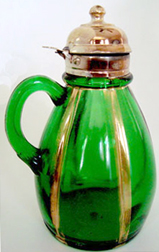 |
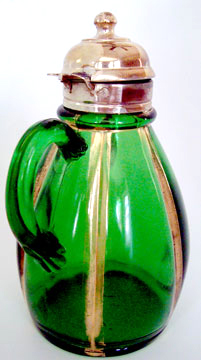 |
| THIS IS THE CREME de la CREME OF EAPG SYRUP PITCHERS. The pattern is Riversides spectacular X-RAY pattern ca. 1899. The GOLD is exquisite and the lid is the original GOLD colored metal. $295 |
||
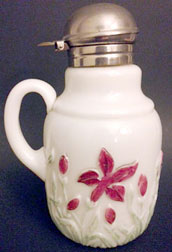 |
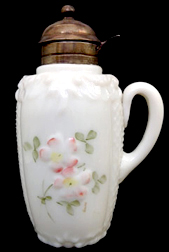 |
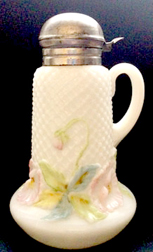 |
| IRIS aka Wild Iris is a Consolidated Lamp & Glass Co. pattern ca. 1897. In milk glass with amazing color remaining on the leaves & flowers. See back HERE. $95 | SCROLL & NET is the appropriate name for this elegant milk glass syrup pitcher.. See Net HERE. The lid is a little rusty but intact. $75 | NETTED w/ POPPIES |
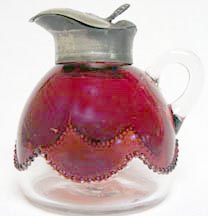 |
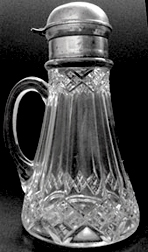 |
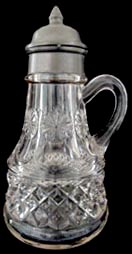 |
| Heisey's #1295 pattern, BEAD SWAG is rarely found in ruby stained pieces. Made ca. 1899, the ruby is in great shape & there is no damage to the glass. $85 |
IMPERIAL NO. 1 aka Three in One aka Fancy Diamonds 7" tall by Imperial Glass Co. ca. 1902. See Back HERE. $75 |
PETTICOAT aka National is a Riverside pattern ca. 1899. The original pewter metal lid is missing its thumb tab but the glass is flawless $95 |
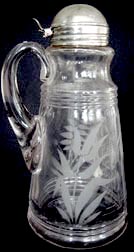 |
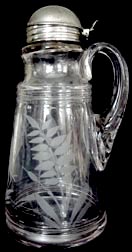 |
 |
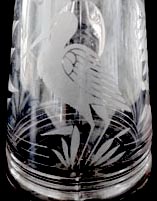 |
| There is apparently no pattern name to this 7 1/2" tall syrup as it is a 'stand alone' piece according to our friend & glass expert, Tom Bredehoft. It is most definitely from the 1880s or even 1870s with beautifully engraved fern-like plants on the 2 sides and a long legged bird standing in grass in the middle section. The tin lid is intact and the glass is flawless. $85 |
|||
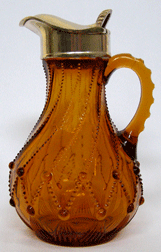 |
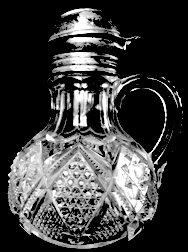 |
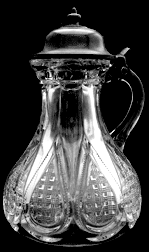 |
| CORD DRAPERY was made by the Indiana Tumbler & Goblet Co. c 1900. It has a flake on the table rim seen HERE. **SOLD** |
MINNESOTA State's pattern by U S Glass co. ca. 1890s. The lid is tilted a little but it is not damaged & the thumb tab works fine. $48 |
FANCY LOOP is Heisey's very popular #1205 pattern c. 1898. $85 |
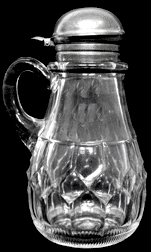 |
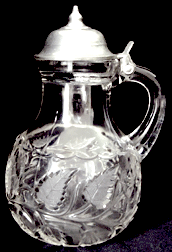 |
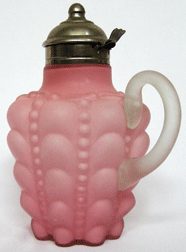 |
| BEAUMONT GLASS FACTORY'S COLUMBIA pattern is from 1899. $75 |
LEAF & FLOWER pattern is Hobbs, Brockunier & Co's. #339 created ca. 1890. No color. $85 |
GUTATTE is a soft satin type of glass made by Consolidated early in the 20th century. It is the taller version & $225. |
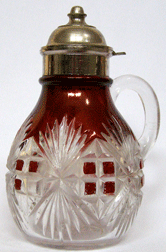 |
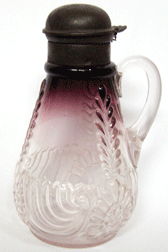 |
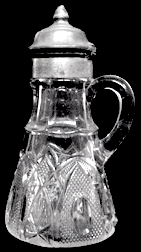 |
| MAJESTIC aka PURITAN pattern was made by McKee c. 1893. In ruby stain, it is $165. |
MEDALLION SPRIG is a glamorous pattern by the West Virginia Glass Co. c. 1894. This has amethyst coloring at the top & is $175. |
NEW HAMPSHIRE Another States' pattern by U S Glass Co. c 1903 Missing thumb tab on lid $78 |
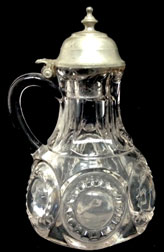 |
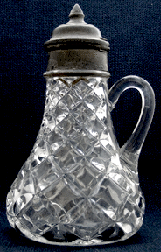 |
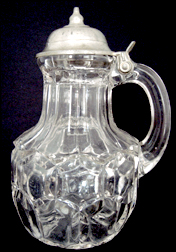 |
| We've heard this pattern called "FLOWER IN GLOBE". We're just calling it CIRCLES. The lid and glass are all great. $65 | PILLOWS, a scarce pattern by Heisey, their #325 c. 1905. Missing lid thumb tab $155. | HEXAGON BLOCK is a substantial pattern. It is Hobbs Brockunier #335 aka Henrietta made ca. 1889. The metal lid is in remarkable condition. $52 |
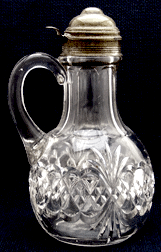 |
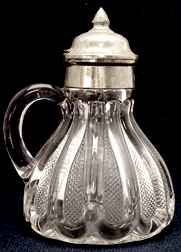 |
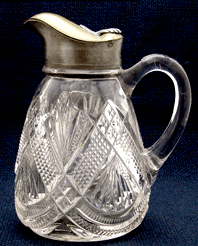 |
| ROYAL CRYSTAL aka ATLANTA pattern was made by the Tarentum Glass Co. c 1894. $95 |
TEXAS aka LOOP W/ STIPPLED PANELS is the States' Series pattern for this great state. c. 1900. Missing lid thumb tab. $235 |
TEPEE aka ARIZONA, although not one of the States' Series patterns. It was made by Geo. Duncan Sons & Co. c 1897. $85 |
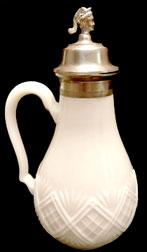 |
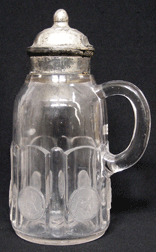 |
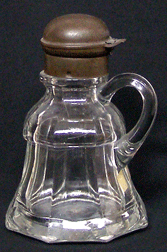 |
| DIAMOND SUNBURST by Bryce Walker ca. 1870s. This pattern does not list a syrup pitcher OR any pieces in Milk Glass. RARE **SOLD** |
U S COIN aka SILVER AGE is the U S Glass pattern made for 6 months in 1892 using actual U S coins in the molds until the Feds confiscated the molds. This one has some damage. If interested, please EMAIL us. |
DOUGLASS pattern was made by Cooperative Flint Glass Co. c. 1903. It will need a new metal lid - this one is just for the photo-op. $55 |
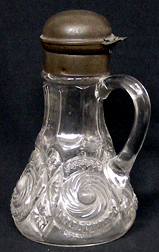 |
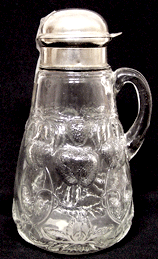 |
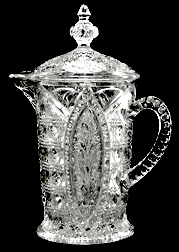 |
| CANNONBALL PINWHEEL aka CALEDONIA is a blown molded syrup made by the U S Glass Co. c. 1908. $85 |
STRAWBERRY PATCH This syrup is very tall for these early vessels - 8" tall. It is not a full line EAPG pattern but a fun Strawberry piece. $95 |
FLORAL OVAL aka BANNER is a John Higbee pattern c. 1910. It could be a creamer or a syrup. There is a small chip under the lip of the lid. Get a load of that finial! $78 |
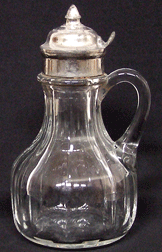 |
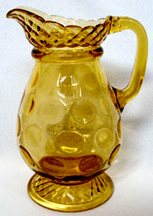 |
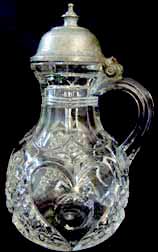 |
| PURITAN, EARLY aka OLD WILLIAMSBURG is a 1903 product of Heisey. $75 |
LATTICE THUMBPRINT (Inverted) aka Rope & Thumbprint by Central Glass Co. ca. 1880s. Called a 'molasses pitcher', these may have originally had a metal lid but one has never been seen by the Central Glass Co. book author. $85 |
HEART W/ THUMBPRINT is by Tarentum Glass Co. ca. 1898. This is the smaller of the 2 syrups in this pattern... 5 3/4" to the top of the lid. Metal is fine - thumb tab missing. See back view HERE $85 |
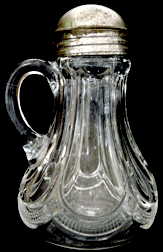 |
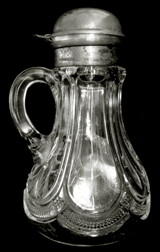 |
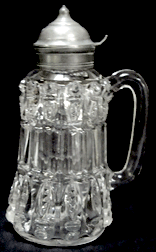 |
| GALLOWAY pattern is by U S Glass Co. - their #15086 ca 1904. The one on the left is 5 3/4" tall and 3 1/2" wide at the widest part & it has a rusty but intact lid sans thumb tab. $95 The one on the right is actually larger, despite the way it looks in the photo. It is 6 1/4" tall & is 3 5/8" across the widest part. Its metal is better & it is $115. A photo of the 2 syrup pitchers together can be seen HERE. |
TORPEDO is aka Pigmy aka Fish Eye by Thompson Glass Co. 1889. It is 7 1/2" tall and has a very good metal lid. $125 |
|
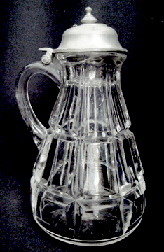 |
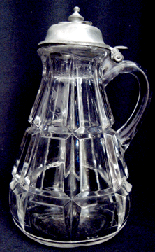 |
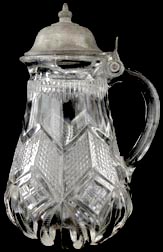 |
| This BLOCK type pattern is unusual and a mystery. It is really 'good' glass, very clear & the blocks are sharply defined. It is 6 1/4" tall to the top of the lid, and in great shape except for the lid. It is a soft metal and has been damaged. Because the lid can't be extricated from the glass, it is only $55. |
IVANHOE by Dalzell, Gilmore & Leighton ca. 1890. Good metal lid; 6 1/2" tall to lid tip. |
|